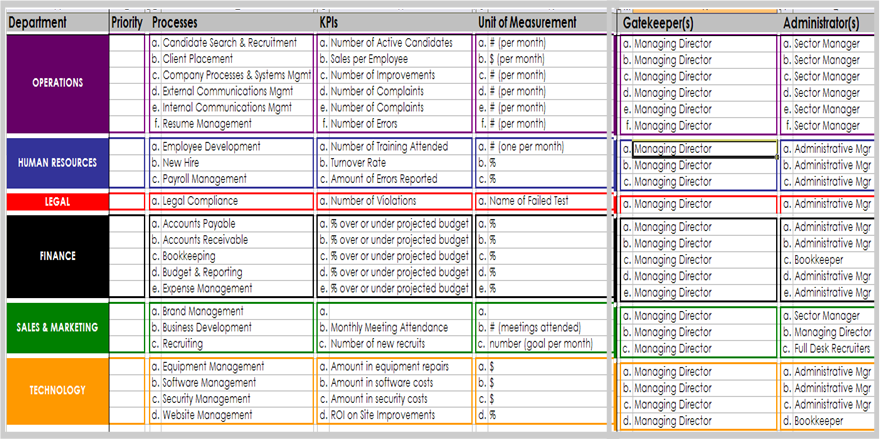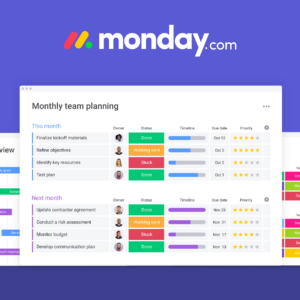Background
Many service-based small businesses often overlook the value of their intellectual property. A business process provides the sequential steps necessary to produce a certain result. Documentation of proprietary information in the form of a business process makes an otherwise intangible asset more tangible and easier to valuate.
Though commonly known as an Operations Manual, at Equilibria we specifically refer to the collection of business processes as the Business Process Manual. The important thing to know is that an Operations Manual is an important equity-building tool that describes your company’s operations with a level of detail and precision that allows staff to work without your daily presence. Moreover, this represents the last step in securing your company’s business infrastructure.
Value of the Service Delivery Process
By documenting your company’s mission-critical operational processes, you can:
- Ensure consistent, high quality work output,
- Leverage in-house knowledge to design a salable, replicable business,
- Attract top quality staff and savvy investors,
- Decrease future employee training time, and
- Identify and concentrate your efforts on revenue generating activities.
What It Looks Like (For Illustrative Purposes Only)
I highly recommend continuing the color-coded system resulting from the Job Task Analysis exercise where each department of your company was assigned a unique color. Each department will have its own 3-ring binder that will house all associated business processes (divided by tabs) as well as additional tools pertaining to that department (i.e., the Paper and Electronic Records Management policies).

The illustrative example above shows a black binder labeled, “Finance.” Black was the color this company’s management chose to associate with financial and accounting related activities. Inside the Finance manual are divider tabs, each of which is labeled according to the process it contains. The example Finance manual above includes divider tabs labeled, “Accounts Receivable,” “Accounts Payable” and “Collections“.
Setup Steps
- Group like job tasks/activities (identified during the Job Task Analysis exercise) per department into processes. For example, tasks such as “email invoice to client,” “collect payment from client,” and “generate invoice in QuickBooks” can be grouped together into a new “Accounts Receivable” process.
- Create a table either in MS Word or MS Excel where the first row contains the following labels in different columns, “Department,” “Priority,” “KPIs,” “Unit of Measurement,” “Gatekeeper(s)” and “Administrator(s)”. See the illustration below in step #3 as a guide.
- Fill in the table. Type the name of each department onto a separate row and consider color-coding for consistency. Type the name of each process identified per department. The Key Performance Indicators (KPIs) represent the metrics that will be used to monitor the performance and effectiveness of each process. The Unit of Measurement represents the unit (e.g., %, ratio) and frequency of each KPI. The Gatekeeper is the person who is responsible for monitoring the process while the Administrator is the person who actually performs the process.

- Determine the order in which you will document processes based on priority. Fill in the number (starting with “1” for most critical) in the table’s Priority column.
- Document each process. A business process can be represented in many formats, the most popular of which are the procedure (sometimes called Standard Operating Procedure) format and the flowchart (also known as a process map). Be sure to include a header and footer on the document indicating the process’ name as well as a disclaimer such as “CONFIDENTIAL.” Consider purchasing process templates from The Process Shop that you can easily download and modify if you do not want to start from scratch.
- Conduct a trial run of each process for accuracy. If possible, ask someone other than the person who is normally expected to perform a process/procedure to test it. This will help you figure out where additional clarification may be needed.
- Store each process both physically and electronically. Hard copies of the processes will go into their respective manual as described earlier in this article. Digital or electronic copies of the processes should be filed according to their respective department (as created during the Electronic Records Management exercise).
- Distribute controlled copies of the Operations Manuals to your staff. Tell them where to find the processes physically (if applicable) and digitally. Make it clear that these processes, now “etched in stone,” are the company’s intellectual property and therefore should not be duplicated or distributed outside the company without your permission.
- Monitor each process and continuously update for improvement. Where possible, determine if/where additional technologies can be integrated to enhance a process’ efficiency. Depending on the size and complexity of your company’s processes, continuous improvement activities can lead you into a more sophisticated (and expensive) quality management tool known as Six Sigma.
Case Study
Why This Matters
If time is money, then how much is yours worth? The best way to ensure that you can effectively disseminate work and leave the office knowing that things won’t fall apart in your absence is through proper business process documentation. Processes give you the metrics and performance management tool needed to systematically monitor business activity.
Be careful not to skip steps! Go through each element of my business infrastructure model to ensure all operational components of your business fit together nicely. If you try to start creating your operations manual without first analyzing what needs to be done and who should do it, you’re guaranteed to get frustrated and the results will seem fragmented and disorganized – in essence, you’ll run the risk of worsening the very problem you’re trying to solve in the first place!











